(完整word版)跨文化交际试题
(完整word版)跨文化交际考试题型
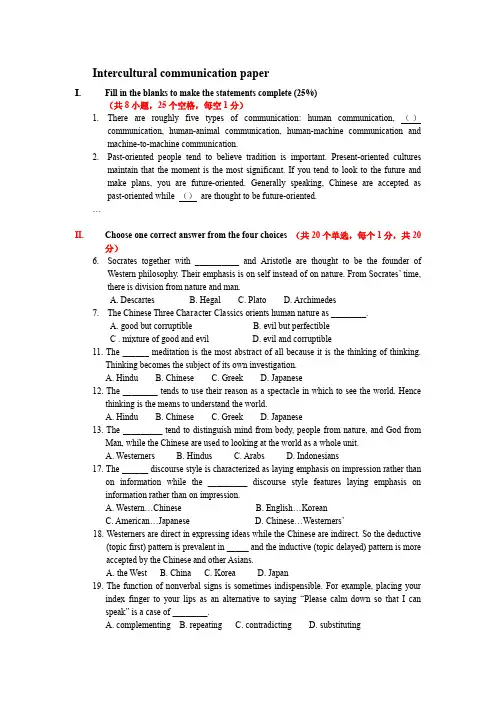
Intercultural communication paperI.Fill in the blanks to make the statements complete (25%)(共8小题,25个空格,每空1分)1.There are roughly five types of communication: human communication, ()communication, human-animal communication, human-machine communication and machine-to-machine communication.2.Past-oriented people tend to believe tradition is important. Present-oriented culturesmaintain that the moment is the most significant. If you tend to look to the future and make plans, you are future-oriented. Generally speaking, Chinese are accepted as past-oriented while ()are thought to be future-oriented.…II.Choose one correct answer from the four choices (共20个单选,每个1分,共20分)6.Socrates together with __________ and Aristotle are thought to be the founder ofWestern philosophy. Their emphasis is on self instead of on nature. From Socrates’ time, there is division from nature and man.A. DescartesB. HegalC. PlatoD. Archimedes7.The Chinese Three Character Classics orients human nature as ________.A. good but corruptibleB. evil but perfectibleC . mixture of good and evil D. evil and corruptible11. The ______ meditation is the most abstract of all because it is the thinking of thinking.Thinking becomes the subject of its own investigation.A. HinduB. ChineseC. GreekD. Japanese12. The ________ tends to use their reason as a spectacle in which to see the world. Hencethinking is the means to understand the world.A. HinduB. ChineseC. GreekD. Japanese13. The _________ tend to distinguish mind from body, people from nature, and God fromMan, while the Chinese are used to looking at the world as a whole unit.A. WesternersB. HindusC. ArabsD. Indonesians17. The ______ discourse style is characterized as laying emphasis on impression rather thanon information while the _________ discourse style features laying emphasis on information rather than on impression.A. Western…ChineseB. English…KoreanC. American…JapaneseD. Chinese…Westerners’18. Westerners are direct in expressing ideas while the Chinese are indirect. So the deductive(topic first) pattern is prevalent in _____ and the inductive (topic delayed) pattern is more accepted by the Chinese and other Asians.A. the WestB. ChinaC. KoreaD. Japan19. The function of nonverbal signs is sometimes indispensible. For example, placing yourindex finger to your lips as an alternative to saying “Please calm down so that I can speak” is a case of ________.A. complementingB. repeatingC. contradictingD. substituting20. In _________ culture, a good girl does not meet the eyes of an adult.A. AmericanB. Puerto RicanC. GermanD. French21. In _________ cultures, it is not uncommon to see men crying in public.A. AsianB. Middle EastC. MediterraneanD. Far East22. Most Arabs, Mediterranean people, Indonesians and people in the Middle East evaluatecloseness as _______. They belong to ______ cultures.A. negative …low contactB. positive …high contactC. positive…low contactD. negative…high contact23. People in ______ cultures usually view silence as lack of communication and aregenerally ________ with it.A. low context…uncomfortableB. high context…uncomfortableC. low context…comfortableD. high context…comfortable24. _________ have _______ personal territory than South Americans.A. North Americans…biggerB. North Americans…smallerC. Africans…biggerD. Africans…smaller25. Traditionally, all people encounter two families: the family they are born into and the onethat is formed. The first is bonded by ______ and the second is from __________.A. blood…marriageB. marriage…bloodC. duty…romanceD. romance…duty…28.Ⅲ. Judge the following statements whether they are true or false (10%)(共10个句子,每句1分)29. In English speaking countries physical contact is generally avoided in conversationamong ordinary friends or acquaintances.30. Americans often smile to cover up confusion or embarrassment.28. Dropping the names of wealthy or famous people the family knows is done in theUnited States, and it is viewed positively.29. It’s one part of American privacy that notebooks should not be looked at by anyonewithout its owner’s permission.31. Values are the core of culture and most culture is hidden.33. White is the traditional color for brides at Chinese weddings.38…Ⅳ. Translate the following (20%)Section A Put the following into Chinese(共10个,每个1分,共10分)39 live-in couples.40 their immediate family.41 funerals and weddings.42 Chinese parents long to see their sons become successful.43 Every dog has his day.44 Mo Tze preached the concept of universal love.45 filial piety.48…Section B Put the following into English(共10个,每个1分,共10分)49 红眼病50开门红51白眼狼52 她皮肤白皙53 我白忙了54纸老虎55 败家子56 荤段子Ⅴ. Fill in the missing information (共5个空格,每个空格1分,共5分)According to Mythical Legends of Mountains and Seas or Shanghaijing: grandson of Yandi,伯陵, had love affairs with Wu Gang’s wife during the three years of Wu’s being away for celestial being, and they gave birth to three sons. Wu killed 伯陵out of furious rage which offended the god of sun, Yandi and Wu ————————(57)。
《跨文化交际》题集
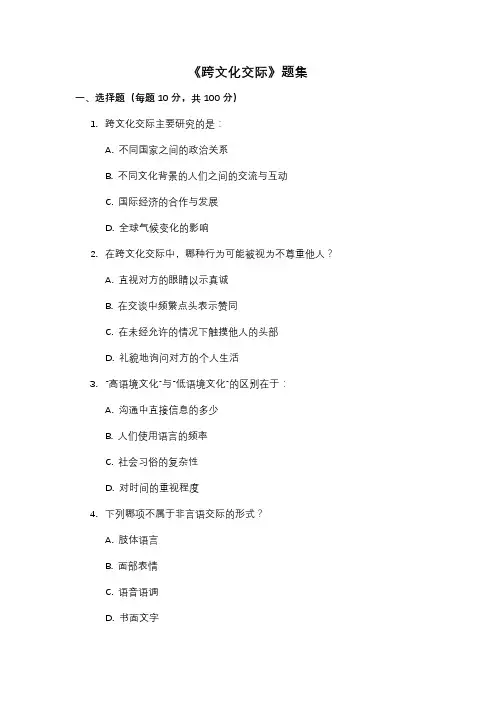
《跨文化交际》题集一、选择题(每题10分,共100分)1.跨文化交际主要研究的是:A. 不同国家之间的政治关系B. 不同文化背景的人们之间的交流与互动C. 国际经济的合作与发展D. 全球气候变化的影响2.在跨文化交际中,哪种行为可能被视为不尊重他人?A. 直视对方的眼睛以示真诚B. 在交谈中频繁点头表示赞同C. 在未经允许的情况下触摸他人的头部D. 礼貌地询问对方的个人生活3.“高语境文化”与“低语境文化”的区别在于:A. 沟通中直接信息的多少B. 人们使用语言的频率C. 社会习俗的复杂性D. 对时间的重视程度4.下列哪项不属于非言语交际的形式?A. 肢体语言B. 面部表情C. 语音语调D. 书面文字5.在一些文化中,沉默可能被视为:A. 同意的标志B. 思考的表示C. 不尊重的行为D. 沟通的一种方式6.“文化休克”通常发生在:A. 一个人长时间处于自己的文化中B. 一个人初次接触并适应新的文化环境时C. 一个人对某种文化有深入了解之后D. 一个人在不同文化之间频繁切换时7.下列哪项是跨文化交际中常见的挑战?A. 语言障碍B. 价值观差异C. 沟通风格的不同D. 以上都是8.在一些文化中,时间被视为一种:A. 可以随意支配的资源B. 必须严格遵守的规则C. 可以用来建立社会关系的工具D. 以上都有可能是,取决于具体的文化9.“面子”在跨文化交际中是一个重要的概念,它通常指的是:A. 一个人的社会地位B. 一个人的自尊心和荣誉感C. 一个人在外貌上的吸引力D. 一个人在经济上的实力10.下列哪项不是促进跨文化交际有效性的策略?A. 增强文化意识B. 发展跨文化沟通技巧C. 避免与不同文化背景的人交往D. 尊重并适应不同的文化习俗二、填空题(每题10分,共50分)1.在跨文化交际中,__________是指由于文化差异而导致的沟通障碍或误解。
2.__________文化强调直接、明确的沟通方式,而__________文化则更注重含蓄和间接的表达。
跨文化交流考试试题及答案
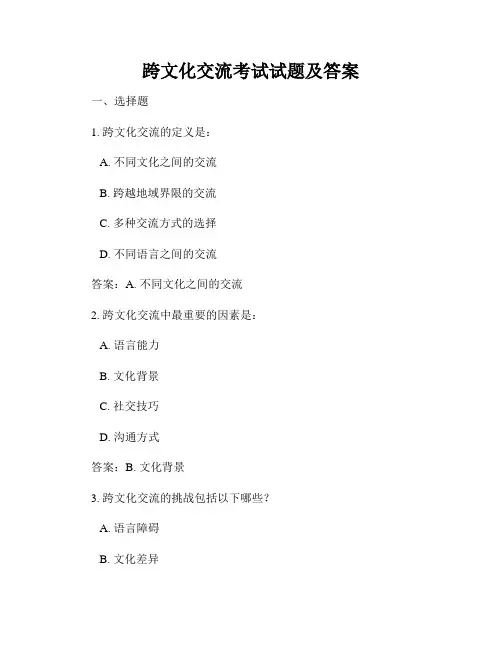
跨文化交流考试试题及答案一、选择题1. 跨文化交流的定义是:A. 不同文化之间的交流B. 跨越地域界限的交流C. 多种交流方式的选择D. 不同语言之间的交流答案:A. 不同文化之间的交流2. 跨文化交流中最重要的因素是:A. 语言能力B. 文化背景C. 社交技巧D. 沟通方式答案:B. 文化背景3. 跨文化交流的挑战包括以下哪些?A. 语言障碍B. 文化差异C. 社交礼仪D. 打破隔阂答案:A. 语言障碍、B. 文化差异4. 在跨文化交流中,以下哪些行为是不恰当的?A. 尊重对方的文化习惯B. 使用简单明了的语言表达C. 批评对方的文化观念D. 遵守当地的社交礼仪答案:C. 批评对方的文化观念5. 跨文化交流的好处包括:A. 增进文化理解B. 缩小文化差异C. 促进国际合作D. 创造更多商机答案:A. 增进文化理解、C. 促进国际合作、D. 创造更多商机二、问答题1. 请简要说明跨文化交流的意义和价值。
跨文化交流具有重要的意义和价值。
首先,它可以增进不同文化之间的理解和尊重,消除误解和偏见,促进友好合作关系的建立。
其次,跨文化交流可以促进文化的多元发展和融合,丰富人们的思想和观念。
此外,跨文化交流有助于拓展商务和经济合作的机会,加强国际间的互利互惠关系。
总之,跨文化交流对于推动全球化进程、促进世界和平与繁荣具有重要的作用。
2. 请列举三种跨文化交流中常见的误解和解决方法。
常见误解:a. 语言障碍:不同语言之间存在的语言障碍常导致误解,解决办法可以是提前学习对方的语言,或者借助翻译工具和专业人士进行沟通。
b. 礼仪差异:不同文化间存在的社交礼仪差异容易导致误解,解决办法是提前了解对方的文化礼仪,尊重对方的习惯,并在交流中保持开放和灵活的态度。
c. 价值观冲突:不同文化之间的价值观存在差异,可能导致观念冲突和摩擦。
解决办法是理解对方的文化背景,尊重差异,以合作和共同利益为出发点,寻求共识和妥善处理分歧。
跨文化交际专业试题及答案
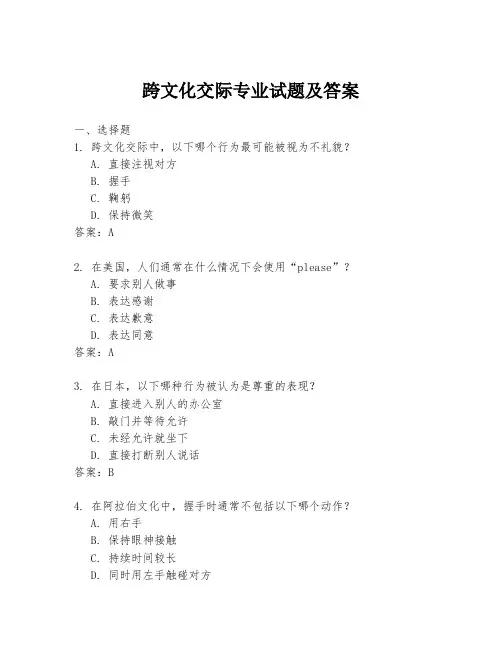
跨文化交际专业试题及答案一、选择题1. 跨文化交际中,以下哪个行为最可能被视为不礼貌?A. 直接注视对方B. 握手C. 鞠躬D. 保持微笑答案:A2. 在美国,人们通常在什么情况下会使用“please”?A. 要求别人做事B. 表达感谢C. 表达歉意D. 表达同意答案:A3. 在日本,以下哪种行为被认为是尊重的表现?A. 直接进入别人的办公室B. 敲门并等待允许C. 未经允许就坐下D. 直接打断别人说话答案:B4. 在阿拉伯文化中,握手时通常不包括以下哪个动作?A. 用右手B. 保持眼神接触C. 持续时间较长D. 同时用左手触碰对方答案:D5. 在中国文化中,赠送礼物时以下哪个行为是不恰当的?A. 包装礼物B. 赠送钟表C. 赠送书籍D. 赠送鲜花答案:B二、简答题1. 描述跨文化交际中非言语交流的重要性。
答案:非言语交流在跨文化交际中起着至关重要的作用,因为它可以传达情感、态度和文化背景。
非言语交流包括肢体语言、面部表情、眼神交流、声音的音调和节奏等。
不同的文化对这些非言语信号有不同的解读,因此理解和正确使用非言语交流对于跨文化沟通的成功至关重要。
2. 解释文化冲击是什么,并给出一个例子。
答案:文化冲击是指一个人在进入一个新文化环境时,由于文化差异而经历的心理和情感上的困惑、焦虑和不适。
例如,一个习惯于个人主义文化的西方人,当他第一次来到一个强调集体主义的亚洲国家时,可能会对那里的团队合作和群体决策感到不适应,从而经历文化冲击。
三、论述题1. 论述在国际商务环境中,了解和尊重不同文化的重要性。
答案:在国际商务环境中,了解和尊重不同文化对于建立和维护商业关系至关重要。
首先,了解不同文化可以帮助我们更好地理解商业伙伴的行为和期望,从而避免误解和冲突。
其次,尊重文化差异可以展示我们的开放性和包容性,这有助于建立信任和尊重,是长期合作关系的基石。
此外,跨文化交际能力也是全球化时代商务人士的重要技能,能够帮助企业在多元文化市场中取得成功。
《跨文化交际》试题(附答案)
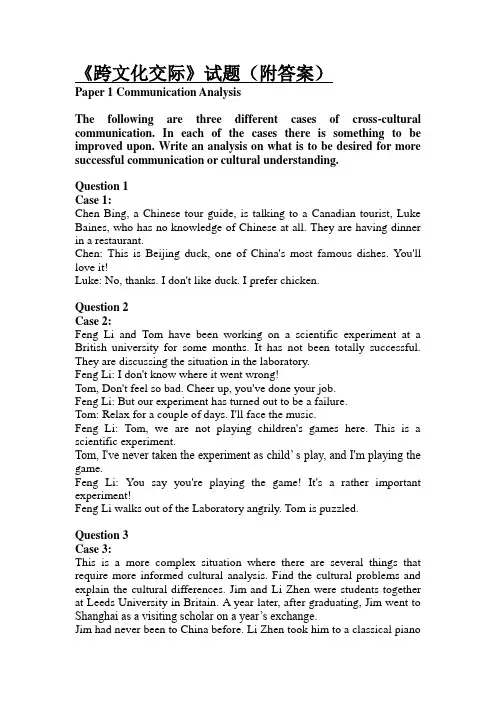
《跨文化交际》试题(附答案)Paper 1 Communication AnalysisThe following are three different cases of cross-cultural communication. In each of the cases there is something to be improved upon. Write an analysis on what is to be desired for more successful communication or cultural understanding.Question 1Case 1:Chen Bing, a Chinese tour guide, is talking to a Canadian tourist, Luke Baines, who has no knowledge of Chinese at all. They are having dinner in a restaurant.Chen: This is Beijing duck, one of China's most famous dishes. You'll love it!Luke: No, thanks. I don't like duck. I prefer chicken.Question 2Case 2:Feng Li and Tom have been working on a scientific experiment at a British university for some months. It has not been totally successful. They are discussing the situation in the laboratory.Feng Li: I don't know where it went wrong!Tom, Don't feel so bad. Cheer up, you've done your job.Feng Li: But our experiment has turned out to be a failure.Tom: Relax for a couple of days. I'll face the music.Feng Li: Tom, we are not playing children's games here. This is a scientific experiment.Tom, I've never taken the experiment as child’ s play, and I'm playing the game.Feng Li: You say you're playing the game! It's a rather important experiment!Feng Li walks out of the Laboratory angrily. Tom is puzzled.Question 3Case 3:This is a more complex situation where there are several things that require more informed cultural analysis. Find the cultural problems and explain the cultural differences. Jim and Li Zhen were students together at Leeds University in Britain. A year later, after graduating, Jim went to Shanghai as a visiting scholar on a year’s exchange.Jim had never been to China before. Li Zhen took him to a classical pianoconcert performed by a famous Chinese pianist. During the performance people were talking and at one stage someone ran up onto the stage and presented the pianist with a bunch of flowers during the playing of a particular musical item. This happened several times during the evening. It also happened when two singers were on stage singing some songs that he was playing. Jim thought all these things quite strange. At the end of the performance the audience applauded the pianist and he applauded them. The audience began to leave while the pianist remained on the stage.Paper 2 VocabularyChoose one word or expression from those in the box below to fill the gap in each of the sentences. Write the correct words in the spaces provided in your answer sheet. Do not change the forms of the4. After twenty five years working in the bank she decided on a different .5. Finally, after arguing about the meal for five minutes it was decided he would .6. Despite the circumstances of the accident there were still some that needed explanation.7. There are many different used when talking about people's relationships in China.8. "Mike! Meet Jane, the ."9. "Ok, the argument is over. Let's forget it, you know."10. People in English speaking countries also avoid losing face or hurting other people by telling .11. It is difficult for foreigners to understand British pub culture, especially the system of which all members of the group are expected to join in.12. It was a crushing blow to her, a hit when she received the news that her husband had left her for another woman.13. In China there is a real sense of in social situations. Paper 3 TranslationTranslate the following passage from English into Chinese. Please write your translation on the answer sheet.What do we mean by "Intercultural Communications" or "IC"? This is not a description of the popular trend toward talking about international things or going overseas. IC is actually an academic and applied discipline that has developed internationally since the 1950s. Sometimes called "cross-cultural communications" or "comparative culture" , scholars most often use the prefix "inter" with the word "cultural" to describe the interaction between cultures. On one level, IC is represented by culture studies, where we examine the political, economic and lifestyle systems of other countries. On another level, it is applied linguistics, where we seek to understand the relationship between language and culture. Many Chinese English teachers and professors have been interested in this aspect since the 1980s - How to teach English in ways that help students also learn the basic communication practices of Britain, the US or other English speaking countries.But the discipline of Intercultural Communications is actually a broad and well-developed field of study. IC is an interdisciplinary application of fields like cultural anthropology, sociology, psychology (and social psychology), communication studies, applied linguistics and educational pedagogy. IC is a comprehensive attempt to understand all aspects of human cultures and how they interact with each other.To understand Intercultural Communications, we seek to understand tradition and modernization, consistency and change. As we understand some of the ongoing national characteristics of a people, we can examine how this culture is seen from the outside, how it interacts with other cultures and how it is changing. In the last thirty odd years, scholars have developed both theoretical framework for comparing cultures and some practical dimensions for considering the similarity and differences between them. One level of intercultural comparison is Cultural Identity. Another level of comparison is Verbal Communication. Another area receiving much attention is Nonverbal Communication. Paper 4 ReadingPassage 1 Questions 15-20In recent years criticisms have been voiced concerning sexist bias in the English language. It has been argued that some of the vocabulary and grammar we use reflects and reinforces a traditional view of the world as one in which men are dominant and women play a secondary role. Takethe word 'chairman' for example. While this can in fact apply to people of both sexes, it appears to some people to be male-oriented as it ends in 'man'. In the past people taking the role of chairman were exclusively male and the word was obviously originally a compound of 'chair' and 'man'. Many English speakers, however, have ceased to view this word as a compound and no more feel it to be composed of these two units, than they perceive cupboard to be a composite of ' cup' and ' board'. In addition the continued use of chairman might be defended on the grounds that the final syllable is pronounced /m'n/ rather than /mn/, just like the final syllable of woman. Despite such considerations other speakers take a contrary view and are sensitive to the components of which it is made up. They clearly perceive it as a title that perpetuates traditional ideas about the place of women in society. For this reason they seek to replace it with neutral terms such as 'chairperson' or 'chair', so that it is now possible to ask questions such as; 'Who is chair of the committee?' Other changes advocated include the replacement of words such as 'postman', 'fireman' and 'policeman' with more clearly neutral terms such as 'postal worker', fire-fighter' and 'police officer’. There is, however, continuing controversy about how far such language changes should go. Should changes be considered for traditional idioms as 'man in the street' and titles such as 'Peking Man'? What about those words where the male meaning of 'man' is no longer dominant, such as 'manhandle'?To the extent that changes have taken place, they have done so more in the written language and formal pronouncements than in everyday speech. You would be quite likely to read in the paper that 'Postal workers are to receive a pay increase.' But 'Has the postman been?' would be most likely to be heard in informal conversation. Here 'postma n’ remains firmly entrenched in popular usage.The extent to which language reflects and shapes attitudes and behaviors is a matter of conjecture. Chinese, Japanese, Persian and Turkish do not make the kinds of sex distinctions English makes through its system of pronouns, but it would be difficult to maintain that males who speak these languages are less sexist than males who speak English! Answer the following questions according to the above text:15. The general use of the word 'man' added to English words indicates .A. sexual feelingsB. sexual freedomC. sexist ideasD. sexist bias .16. Generally where language and sex are concerned in Britain .A. all people agree change is neededB. some people agree change is neededC. people can't make up their minds on the issueD. people think the issue is unimportant and not serious17. What example does the author give to support a defense of the word 'chairman'?18. What does the author argue for when the example 'manhandle' is given?19. What does the author have to say about the impact of language changes?20. What is the author's argument in the final paragraph?Passage 2 Questions 21-27Can Computers Do a Better Job Rating Stocks?Since May, Charles Schwab has been providing stock ratings to clients using a computerized system that it says tries to remove human bias.In particular, Schwab says, its system is meant to avoid the conflicts of interest that have plagued traditional brokerage firms, whose research analysts have often acted as cheerleaders for companies being courted by their investment bankers."We believe that our single biggest advantage is our objectivity," said Jerry Chafkin, Schwab's executive vice president for investment advice and products. " While the development of the methodology is human, the analysis is being performed systematically and automatically.Though Schwab is perhaps the most prominent financial services company to use a computer-driven rating system, several others, including Value Line and Zacks Investment Research, pick stocks in a similar way.The various systems produce very different ratings of individual stocks, and their ability to outperform a market index fund over time has not been proved conclusively. The verdict is still out as to whether computers do it better than people. What is clear, though, is that the major computerized systems hand out fewer positive stock ratings than do Wall Street analysts, who seem to give them out very generously.People who run computerized selection systems criticize traditional Wall Street analysis as having institutional conflicts of interest, as well as individual bias. "I am very suspicious about opinions and judgments and emotions by humans in individual stock selection," said Samuel Eisenstadt, Value Line's research director.However, the computer-driven stock-picking systems must rely on the selection criteria of their creators. All try to isolate factors that their developers believe have the greatest ability to predict share prices. Most models compare a company9s historical earnings growth with that of other companies. And many track the extent to which earnings have surprised analysts.Many firms use their computer-based stock-rating systems as marketing tools.The designers of these systems say they should be judged on how a group of stocks performs over time. But all the systems assume, as do stock analysts on Wall Street, that superior research, by humans, and analysis can select a group of stocks that will outperform the market averages over the long run.Market analysts say it is too soon to assess the fledgling Schwab system or new models, like Microsoft's year-old Stock-ScouterMark the following statements True (T) / False (F) / Not Given (NG) according to the information provided in the text.Write T, or F or NG on your answer sheet in the spaces provided for questions.21. Charles Schwab is a computer company.22. The method of operation by Schwab is done automatically.23. 'Value Line' and 'Zacks' have similar operating methods to Schwab.24. There is no conclusive proof that computers perform better than humans.25. Wall Street analysts are generous in rating stocks.26. Human beings make value judgments according to the research director of 'Value Line'.27. Analysts are surprised at the growth rate of share prices.答案及评分标准Paper 1: Communication Analysis●The following points should be covered in the analysis.●Award one point for each of the points covered (underlined). Paper 2: Vocabulary●One point for each item.●Answers must be the same as the key.4. vocation5. foot the bill6. grey areas7. kin terms8. trouble and strife 9. live and let live10. white lies 11. buying a round12. below the belt 13. communityPaper 3: Translation14.“跨文化交际”或“IC”是指什么呢?这并不是对于谈论国际事务或出国大潮的描述。
跨文化交际试题及答案
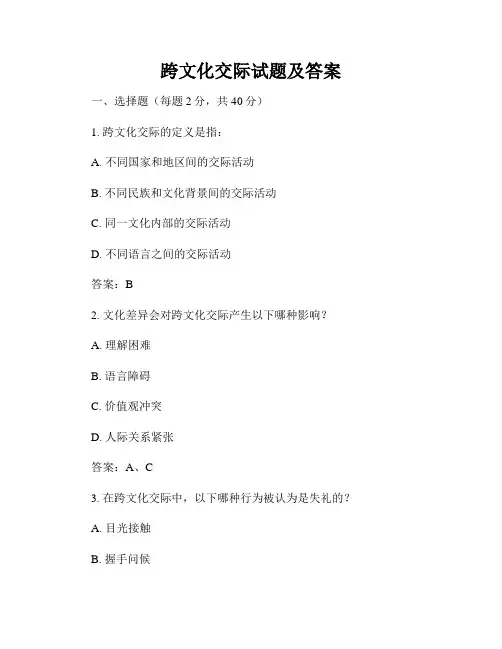
跨文化交际试题及答案一、选择题(每题2分,共40分)1. 跨文化交际的定义是指:A. 不同国家和地区间的交际活动B. 不同民族和文化背景间的交际活动C. 同一文化内部的交际活动D. 不同语言之间的交际活动答案:B2. 文化差异会对跨文化交际产生以下哪种影响?A. 理解困难B. 语言障碍C. 价值观冲突D. 人际关系紧张答案:A、C3. 在跨文化交际中,以下哪种行为被认为是失礼的?A. 目光接触B. 握手问候C. 低头鞠躬D. 打招呼时用双手表示敬意答案:C4. 在中国文化中,以下哪种颜色象征喜庆和幸福?A. 黑色B. 红色C. 绿色D. 白色答案:B5. 在进行跨文化交际时,以下哪种策略是最有效的?A. 强调自己的文化优势B. 忽视文化差异C. 遵守对方的文化规范D. 强迫对方接受自己的文化观念答案:C二、简答题(每题10分,共30分)1. 请简要阐述跨文化交际的重要性以及其中存在的挑战。
答案:跨文化交际的重要性在于增进各国间的相互了解和友谊,推动跨国合作和发展。
然而,跨文化交际也面临着重重挑战,如语言沟通障碍、文化差异带来的不解和冲突,以及对他人观点和习俗的理解困难等。
2. 在国际商务谈判中,如何合理利用非语言交际手段?答案:在国际商务谈判中,非语言交际手段可以帮助加强沟通效果。
可以通过身体语言表达自信和诚意,比如坐姿、目光接触和手势运用等;可以通过服饰和礼仪来展示对对方文化的尊重;还可以通过图表和演示文稿等视觉媒介来辅助表达和说明。
3. 请简要解释文化冲突是如何产生的,并提出解决文化冲突的建议。
答案:文化冲突是由于不同文化之间的差异而产生的,当个体或群体面对不熟悉的文化规范和价值观时,可能会感到困惑和不满。
为解决文化冲突,建议应采取以下措施:学习和了解对方文化,加强跨文化交际能力;尊重差异,避免对他人价值观的评判和偏见;建立良好的沟通渠道,积极解释自己的观点并倾听对方的意见;寻求共同利益和双赢的解决方案。
(完整word版)-跨文化交际试卷A及答案
……………………………………………………………………………………………………Part ⅠDecide whether the following 10 statements are True or False. Write the answers in the blanks. (2% for each, 20%)1. People do not exchange greetings with people almost every day.2. If you want to know where a person was born, you can ask “Where are you originally from?”3. For women, in more informal business situations, should dress in a conservative suit or a well tailored dress.4. Conversations about children and family usually do not have their place in “networking ” situations for business.5. At conventions, it is absolutely necessary to participate or at least make an appearance at most organized functions.6. If you are the hostess, don ’t insist that someone else drink and don ’t over serve.7. There are enough people in the world who have problems mastering vehicles andphones individually.8. It is advisable not to wear the earpiece when we are not on the phone.9. Overdrinking alcohol can lower a person’s inhibitions and alter his judgment.10. Most meetings are unnecessary; they are just a way of making people feel important.1.在地球村里,国家就像一个大家庭,各大洲就像是邻居。
跨文化交际概论题集
跨文化交际概论题集一、选择题1. 跨文化交流的主要目的是()A. 传播本国文化B. 了解和尊重不同文化C. 实现经济利益D. 推广语言答案:B2. 跨文化交流的定义强调()A. 不同种族之间的交流B. 不同文化背景人们的互动C. 国际间的政治交流D. 语言的转换答案:B3. 跨文化交流的重要性体现在()A. 促进全球经济发展B. 增进文化理解与和谐C. 加强国际政治合作D. 以上都是答案:D4. 下列哪项不属于跨文化交流的要素()A. 语言B. 价值观C. 地理位置D. 风俗习惯答案:C5. 跨文化交流对个人的影响包括()A. 提升文化敏感度B. 拓宽思维方式C. 增强适应能力D. 以上都是答案:D6. 跨文化交流的意义在于()A. 消除文化差异B. 促进文化融合C. 保护本土文化D. 以上都不是答案:B7. 以下关于跨文化交流的描述,正确的是()A. 只涉及语言的交流B. 是一种单向的信息传递C. 包括文化的相互影响和适应D. 不需要考虑文化背景答案:C8. 跨文化交流的定义涵盖了()A. 不同国家之间的交流B. 不同民族之间的交流C. 不同文化群体之间的交流D. 以上都是答案:D9. 跨文化交流的重要性在于它能够()A. 提高国际竞争力B. 丰富个人经历C. 促进文化创新D. 以上都是答案:D10. 下列哪项不是跨文化交流的挑战()A. 语言障碍B. 文化偏见C. 相似的文化背景D. 价值观差异答案:C11. 跨文化交流有助于()A. 培养全球视野B. 增强民族自豪感C. 推广本国文化D. 以上都是答案:D12. 跨文化交流的定义不包括()A. 文化的冲突与对抗B. 文化的理解与尊重C. 信息的传递与共享D. 人际关系的建立答案:A13. 跨文化交流对社会的影响包括()A. 促进社会进步B. 增加文化多样性C. 加强社会凝聚力D. 以上都是答案:D14. 以下关于跨文化交流重要性的说法,错误的是()A. 可以避免文化冲突B. 有助于推动文化发展C. 能够促进国际合作D. 是全球化的必然趋势答案:A15. 跨文化交流的关键是()A. 掌握多种语言B. 了解不同文化的特点C. 拥有丰富的知识D. 具备良好的沟通技巧答案:B16. 跨文化交流的定义涉及到()A. 文化的传承B. 文化的变迁C. 文化的比较D. 以上都是答案:D17. 跨文化交流的重要意义在于()A. 提高文化认同感B. 促进文化交流与合作C. 保护文化遗产D. 以上都是答案:D18. 下列哪项是跨文化交流的积极作用()A. 减少文化误解B. 增进文化认同C. 促进文化发展D. 以上都是答案:D19. 跨文化交流的定义中强调的是()A. 文化的共性B. 文化的差异C. 文化的交流与融合D. 以上都是答案:D20. 跨文化交流的重要性在全球化背景下变得()A. 更加突出B. 逐渐减弱C. 没有变化D. 难以确定答案:A21. 以下哪种文化差异属于宗教信仰的差异?()A. 对神灵的崇拜方式不同B. 对建筑风格的喜好不同C. 对艺术形式的欣赏角度不同D. 对节日庆祝方式的不同答案:A22. 文化差异中的审美观念差异表现在()A. 对音乐风格的偏好不同B. 对服装款式的选择不同C. 对自然景观的审美标准不同D. 以上都是答案:D23. 教育体系的差异属于文化差异的哪种类型?()A. 教育目标的不同B. 教学方法的不同C. 教育资源的分配不同D. 以上都是答案:D24. 家庭观念的差异包括以下哪些方面?()A. 家庭成员的角色和责任不同B. 家庭关系的重视程度不同C. 家庭教育的方式不同D. 以上都是答案:D25. 以下哪种文化差异属于思维方式的差异?()A. 对逻辑推理的重视程度不同B. 对直觉和经验的依赖程度不同C. 对问题解决的方法不同D. 以上都是答案:D26. 文化差异中的饮食文化差异包括()A. 食物种类的不同B. 烹饪方式的不同C. 用餐礼仪的不同D. 以上都是答案:D27. 艺术表现形式的差异属于文化差异的哪种类型?()A. 绘画风格的不同B. 文学作品的主题和风格不同C. 音乐节奏和旋律的不同D. 以上都是答案:D28. 社会规范的差异包括以下哪些方面?()A. 道德准则的不同B. 法律制度的不同C. 社交礼仪的不同D. 以上都是答案:D29. 以下哪种文化差异属于历史传统的差异?()A. 对历史事件的评价不同B. 对传统文化的传承方式不同C. 对历史人物的纪念方式不同D. 以上都是答案:D30. 文化差异中的语言文字差异包括()A. 文字形式的不同B. 词汇含义的不同C. 语法结构的不同D. 以上都是答案:D31. 价值观的差异可以体现在()A. 对成功的定义不同B. 对幸福的追求不同C. 对人际关系的重视程度不同D. 以上都是答案:D32. 审美标准的差异包括以下哪些方面?()A. 对美的定义不同B. 对艺术作品的评价不同C. 对自然景观的欣赏角度不同D. 以上都是答案:D33. 宗教仪式的差异属于文化差异的哪种类型?()A. 宗教活动的形式不同B. 宗教信仰的对象不同C. 宗教教义的解释不同D. 以上都是答案:D34. 文化差异中的时间观念差异表现在()A. 对时间的重视程度不同B. 时间安排的方式不同C. 对准时的理解不同D. 以上都是答案:D35. 空间观念的差异包括以下哪些方面?()A. 对个人空间的需求不同B. 对建筑布局的喜好不同C. 对地理位置的重视程度不同D. 以上都是答案:D36. 以下哪种文化差异属于社会结构的差异?()A. 社会组织形式的不同B. 社会阶层的划分方式不同C. 社会权力分配的不同D. 以上都是答案:D37. 文化差异中的性别观念差异包括()A. 对男女角色的定义不同B. 对性别平等的认知不同C. 对性别行为的规范不同D. 以上都是答案:D38. 艺术创作动机的差异属于文化差异的哪种类型?()A. 对艺术表达的目的不同B. 对艺术创新的追求不同C. 对艺术传统的尊重程度不同D. 以上都是答案:D39. 以下哪种文化差异属于民俗习惯的差异?()A. 对节日庆祝的方式不同B. 对婚礼仪式的重视程度不同C. 对民间传说的传承方式不同D. 以上都是答案:D40. 文化差异中的教育观念差异包括()A. 对教育目的的理解不同B. 对教育方法的选择不同C. 对教育资源的分配不同D. 以上都是答案:D41. 文化休克通常发生在()A. 初次进入不同文化环境时B. 长期生活在同一文化环境中C. 与不同文化背景的人交流时D. 学习其他文化知识时答案:A42. 文化休克的主要表现包括()A. 焦虑、孤独、困惑B. 兴奋、好奇、激动C. 平静、适应、融入D. 自信、乐观、开朗答案:A43. 以下哪种情况可能导致文化休克加剧?()A. 积极学习当地语言和文化B. 与当地人保持密切联系C. 固执地坚持自己的文化观念D. 尝试适应新的生活方式答案:C44. 文化适应的过程通常包括()A. 接触、冲突、调整、适应B. 了解、接受、融入、认同C. 观察、模仿、学习、创新D. 排斥、抵制、妥协、适应答案:A45. 当面临文化休克时,以下哪种应对方式是积极的?()A. 逃避现实,拒绝与外界接触B. 抱怨和指责当地文化C. 保持开放的心态,努力适应D. 坚持自己的文化传统,不做改变答案:C46. 文化适应的阶段中,“蜜月期”的特点是()A. 对新文化充满好奇和兴奋B. 开始感受到文化差异带来的压力C. 逐渐适应新文化,融入当地生活D. 对原文化产生强烈的怀念答案:A47. 文化休克的程度可能受到()的影响。
跨文化交流考试题
Examination1.what is intercultural communication?what have you learned from this class?Intercultural communication is a form of communication that aims to share information across different cultures and social groups. It is used to describe the wide range of communication processes and problems that naturally appear within an organization or social context made up of individuals from different religious, social, ethnic, and educational backgrounds. Intercultural communication is sometimes used synonymously with cross-cultural communication. In this sense it seeks to understand how people from different countries and cultures act, communicate and perceive the world around them. Many people in intercultural business communicationargue that culture determines how individuals encode messages, what medium they choose for transmitting them, and the way messages are interpreted.[1] The European researcher Daniele Trevisani pointed out the semantic distinction between Intercultural and Cross-Cultural Communication should be clearly specified: Intercultural Communication properly refers to the study of the "interaction" between people from different cultures, while Cross-Cultural Communication specifically refers to the comparisonof how people from different cultures communicate. In other words,Cross-Cultural Communication is a "static differential image" depicting differences in communication patterns across different cultures, while Intercultural Communication studies "dynamic interactional patterns", what happens when people from at least two different cultures meet and interact, and what "frames" are generated from this interaction, e.g. understanding vs. misunderstanding, agreement vs. disagreement, cultural adaptationvs. cultural isolation, emerging of "third cultures", conflict vs. cooperation, intercultural team cohesiveness vs. team misunderstandings, intercultural projects success vs. projects failure, emotional improvement vs. emotional deterioration, and any other relational outcome (Trevisani, 2005).[2] In a broader sense, Intercultural communication encompasses cross-cultural communication, international communication, development communication, and intercultural communication's narrower referent, intercultural communication proper.[3] With regard to intercultural communication proper, it studies situations where people from different cultural backgrounds interact. Aside from language, intercultural communication focuses on social attributes, thought patterns, and the cultures of different groups of people. It also involves understanding the different cultures, languages and customs of people from other countries. Intercultural communicationplays a role in social sciences such as anthropology, cultural studies, linguistics, psychology and communication studies. Intercultural communication is also referred to as the base for international businesses. There are several cross-cultural service providers around who can assist with the development of intercultural communication skills. Research is a major part of the development of intercultural communication skills.[4][5]2.Explain the difference between verbal communication and non-verbal communication in details.--Verbal communicationconsist of messages being sent and received continuously with the speaker and the listener, it is focused on the way messages are portrayed. Verbal communication is based on language and use of expression, the tone in which the sender of the message relays the communication can determine how the message is received and inwhat context.Factors that effect verbal communication:• Tone of voice• Use of descriptive words• Emphasis on certain phrases• Volume of voiceThe way a message is received is dependent on these factors as they give a greater interpretation for the receiver as to what is meant by the message is. By emphasizing a certain phrase with the tone of voice, this indicates that it is important and she be focused more on.Along with these attributes verbal communication is also accompanied with non-verbal cues. These cues make the message clearer and give the listener an indication of what way the information should be received.[23]Example of non-verbal cues• Facial expressions• Hand gestures• Use of objects• Body movementIn terms of intercultural communication there are language barriers which are effected by verbal forms of communication. In this instance there is opportunity for miscommunication between two or more parties.[24] Other barriers that contribute to miscommunication would be the type of words chosen in conversation. do to different cultures there are different meaning in vocabulary chosen, this allows for a message between the sender and receiver to be misconstrued.[25]6.Explain the pros and cons of nonverbal communication.Nonverbal Communication[edit]Nonverbal communication is behavior that communicateswithout words—though it often may accompanied by words.Nonverbal behavior can include things such as• facial expressions and gestures• clothing• movement• posture• eye contact.[26]When these actions are paired with verbal communication amessage is created and sent out. A form of nonverbal communicationis kinesic behaviour. Kinesic behaviour is communication through body movement—e.g., posture, gestures, facial expressions and eye contact. The meaning of such behaviour varies across countries and affects intercultural communication. A form of kinesic nonverbalcommunication is eye contact and the use of the eyes to convey messages. Overall, nonverbal communication gives clues to what isbeing said verbally by physical portrayals.Nonverbal communication techniques used around the worldand in multiple cultures.Nonverbal communication and kinesic is not the only way to communicate without words. Proxemics, a form of nonverbal communication, deals with the influence of proximity and space on communication. Another form of nonverbal behaviour andcommunication dealing with intercultural communication is paralanguage. Paralanguage refers to how something is said, rather than the content of what is said—e.g., rate of speech, tone and inflection of voice, other noises, laughing, yawning, and silence. Paralanguage will be later touched on in the verbal section of intercultural communication.Nonverbal communication has been shown to account for between 65% and 93% of interpreted communication.[27] Minor variations in body language, speech rhythms, and punctuality often cause mistrust and misperception of the situation among cross-cultural parties. This is where nonverbal communication can cause problems withintercultural communication. Misunderstandings with nonverbal communication can lead to miscommunication and insults withcultural differences. For example, a handshake in one culture may be recognized as appropriate, whereas another culture may recognize itas rude or inappropriate.[27]Nonverbal communication can be used without the use of verbal communication. This can be used as a coding system for people who donot use verbal behaviour to communicate in different cultures, where speaking is not allowed.[28] An facial expression can give cues to another person and send a message, without using verbal communication.Something that usually goes unnoticed in cultures and communication is that clothing and the way people dress is used as aform of nonverbal communication. What a person wears can tell a lotabout them. For example, whether someone is poor or rich, young orold or if they have specific cultures and beliefs can all be said through clothing and style. This is a form of nonverbal communication.Overall, nonverbal communication is a very important concept in intercultural communication.3.Based on the Kluekhohn’s model ,explain American CultureValue in detail.1) = Human nature orientation 人性取向Westerners believe that human nature is basically evil due to their original sin.However, the evil nature can be saved through salvation,if one believes in Jesus and continues doing good things.2) = Man-nature orientation 人天取向Americans have historically believed that nature was somethingthat could and had to be mastered.Early West European immigrantsto North America encountered a vast, unforgiving wilderness that they set about to “tame”,and modern astronaut are working to “conquer” the space.时间取向3) = Time orientationFuture-orientated cultures emphasize what is to come and expectthe future to be grander and nicer than the present . The word “old”is associated with “falling behind” and “uselessness”, while the word “new” is related to progress,change and challenge.future orientation prevails in the western culture. Western people tend to believe that future should be grander and nicer than the present.In the future-oriented cultural context, it is easy for new products or new services to trigger consumers desire to buy. That iswhy the English advertisements tend to stress repeatedly that the advertised products are new。
跨文化沟通期末考试题及答案
跨文化沟通期末考试题及答案一、选择题(每题2分,共20分)1. 跨文化沟通中,以下哪项不是文化差异的表现?A. 语言差异B. 饮食习惯C. 宗教信仰D. 个人兴趣答案:D2. 在跨文化沟通中,以下哪个行为可能被视为不礼貌?A. 握手B. 鞠躬C. 直视对方D. 赠送礼物答案:C3. 跨文化沟通中,以下哪个概念强调了文化对个体行为的影响?A. 个人主义B. 集体主义C. 权力距离D. 所有以上选项答案:D4. 根据霍夫斯泰德的文化维度理论,以下哪个维度不是其分类之一?A. 个人主义与集体主义B. 男性化与女性化C. 长幼有序D. 权力距离答案:C5. 在跨文化沟通中,以下哪个策略不是有效的沟通策略?A. 保持开放心态B. 避免使用肢体语言C. 尊重文化差异D. 积极倾听答案:B二、填空题(每空1分,共10分)6. 在跨文化沟通中,_________是指在不同文化背景下,人们对于同一事件或行为的不同理解和解释。
答案:文化相对主义7. 跨文化沟通的障碍之一是_________,即对其他文化持有偏见或刻板印象。
答案:文化偏见8. 跨文化沟通中,_________是指在不同文化间进行有效交流的能力。
答案:跨文化能力9. 跨文化沟通中,_________是指在不同文化背景下,人们对于时间的理解和使用方式。
答案:时间观念10. 跨文化沟通中,_________是指在不同文化背景下,人们对于空间的理解和使用方式。
答案:空间观念三、简答题(每题10分,共20分)11. 简述跨文化沟通中的语言障碍及其克服方法。
答案:语言障碍包括语言差异、非言语沟通差异等。
克服方法包括学习对方的语言、使用简单明了的表达、利用肢体语言辅助沟通、寻求翻译帮助等。
12. 描述跨文化沟通中的文化适应过程。
答案:文化适应过程通常包括四个阶段:蜜月期、文化休克期、调整期和融入期。
在蜜月期,人们对于新文化充满好奇和兴奋;文化休克期则可能感到困惑和挫败;调整期是逐渐适应新文化的过程;最后,在融入期,人们能够自如地在新文化中生活和工作。
- 1、下载文档前请自行甄别文档内容的完整性,平台不提供额外的编辑、内容补充、找答案等附加服务。
- 2、"仅部分预览"的文档,不可在线预览部分如存在完整性等问题,可反馈申请退款(可完整预览的文档不适用该条件!)。
- 3、如文档侵犯您的权益,请联系客服反馈,我们会尽快为您处理(人工客服工作时间:9:00-18:30)。
1.Three international developments have made intercultural contact more pervasive (无处不在), they are .(D )A. new technology and information systemB. changes in the world’s populationC. a shift in the world’s economic arenaD. A, B and C2.___C___ has evolved that lets societies share cultural experiences with one another as films are produced and shown around the world.A. Show businessB. I.T.C. international film industryD. Mass media3.__A____ in the United States, because they have been profoundly affected by population and immigration increases, are a primary setting for domestic intercultural contact.A. SchoolsB. CommunityC. WorkplaceD. club4. It is difficult to find a single definition of human communication because__D____.A. the complex nature of communicationB. the issue of intentionalityC. the issue of unintentionalityD. A, B and C5. To Reusch and Bateson, communication often takes place __A___.A. without awarenessB. consciouslyC. intentionallyD. deliberately6. Which of the statements of communication is not true? DA. Communication is dynamicmunication is symbolicmunication is InterpretiveD. Communication is static7. Communication has a consequence means that ___D___.A. Communication is irreversibleB.Our response to message does not have to be immediateC. The nature of our responses to messages is rooted in our cultureD. A, B and C8. Which of the item is not the basic component of culture? CA. ValuesB. EmotionsC. PersonalityD. Attitudes9. We learn our culture not through __D______.A. proverbsB. artC. mass mediaD. self-taught10.Although many aspects of culture are subject to change, the _B______ of a culture resists major alterations.A. historyB. the deep structureC. backgroundD. tradition11. ___C___ is at the core of intercultural communication.A. senderB. receiverC. cultureD. language12. Although cultures change through several mechanisms, which of the following item is not the three most common ones.CA. DiffusionB. AcculturationC. InventionD. Innovation13. One of the most difficult tasks for foreigners in learning a new language is learning the _____A____ and ________ in which they are used.A. different styles, the contextsB. grammar, accentC. different styles, the speech actsD. vocabulary, the pronunciation14. Language is accompanied by a continuous flow of nonverbal communication, which involves not only ____ but also ____ and _____.BA. the tone, gaze, postureB. the voice, the face, the bodyC. the pitch, gaze, gestureD. the pace, the distance, touch15. ___B__ is the process of selecting, organizing, and interpreting sensory data in a way that enables us to make sense of our physical and social world.A. InterpretationB. PerceptionC. AnalysisD. Understanding16. The maps are usually drawn by putting one’s country in the center. This illustrates ___B___.A. MisinterpretationB. Racial biasC. EthnocentrismD. Stereotype17. Many stereotypes are provided by the ____D____.A. School educationB. TextbookC. HistoryD. Mass media18. Cultural breakdowns, setbacks or conflicts result from misinterpretations, ethnocentrism, and stereotype as a result of ___A____.A. MisperceptionB. Racial biasC. MisunderstandingD. False impression19. ___C__ are defined as “an enduring set of beliefs that serve to guide or direct our behavior”.A. LawsB. PerceptionsC. ValuesD. World views20. Which of the statements about cultural values is not true?BA.Cultural values, as is the case with cultural beliefs, guide both perception and communication.B. Cultural values have nothing to do with individual values.C.Cultural values are prescriptive.D.Cultural values, once formed, are enduring and relatively stable.21. Which of the countries doesn’t belong to individualistic culture?DA. ItalyB. New ZealandC. FranceD. Greece22. In a high power distance culture, the superior tends to BA.treat employees respectfullyB.display his authorityC. interact with workers more oftenD.do important work23. Which of the statements about low uncertainty avoidance is not true? CA.Divers population.B.Frequent innovations.C.Generally older countries with a long history.D. Citizens are proud of nation.24. Which of the following countries or region of no feminine traits? DA. NorwayB. FinlandC. DenmarkD. Austria25. Language ______ cultural reality. A B DA. ExpressesB. EmbodiesC. InfluencesD. Symbolizes26.It is a universal truth that language is __A___ by culture and in turn it ______ culture.A.influenced, reflectsB.displayed, influencesC. determined, reflectsD.shaped, influences27. Language is the __D____ representation of a people, and it comprises their historical and cultural backgrounds as well as their approach to life and their ways of living and thinking.A. PrescriptiveB. AbstractC. SubstantialD. Symbolic28. Which of the contextual cues do not matter in a high-context culture? BA. The type of relationship that exists between the speaker and the listener.B. The coded, explicit message.C. Age relative to the speaker and the listener.D.Where is the communication taking place?29. The low-context culture doesn’t have which of the characteristics. CA.Tends to develop transitory personal relationship.B. Tends to use "logic" to present ideas.C.Tends to give simple, ambiguous, non-contexting messages.D.Values individualism.30. The following advantages of high-context culture don’t include ___B___.A.it saves us making many trivial decisions;B.it allows for great flexibility, adaptability and originality;C.roles tend to be clear;D.group projects and team efforts tend to be practicable and effective.31. P eople from cultures that prefer “high involvement” styles tend to __A_______.A. expect to be interruptedB. use polite listening soundC.give plenty of positive and respectful responses to their conversation partnersD. speak one at a time32. People from “high considerateness” cultures are often thought to be __B______.A. loudB. passiveC. chattyD. pushy33. One way to determine whether a culture favors a direct or indirect style in communication is ________A_____.A. H ow they say, “No.”B. How they invite people.C. How they teach people.D. How they accept people.34. In 2010, the Easter is on ___A______.A. 4th, AprilB.5th, AprilC. 2nd, AprilD. 6th, April35. Which of the communication style can’t be characterized as high considerateness? DA. ChineseB. JapaneseC. Mainstream AmericanD. Russian Define the following concept. (4 points for each of the 5 items)(1)Culture (第三章第十一页)According to The Concise Oxford Dictionary,culture is “the arts and other manifestations(表现) of human intellectual achievement regarded collectively”.We define culture as “the deposit of knowledge, experience, beliefs, values, actions, attitudes, hierarchies, religions, notions of time, roles, spatial relations, concepts of the universe, and artifacts acquired by a group of people in the course of generations through individual and group striving.”(文化是个人和群体在种族发展过程中所获得的知识、经验、信仰、价值观、行为、态度、阶级、宗教、时间观、角色、空间观、宇宙观和艺术品的集合。
